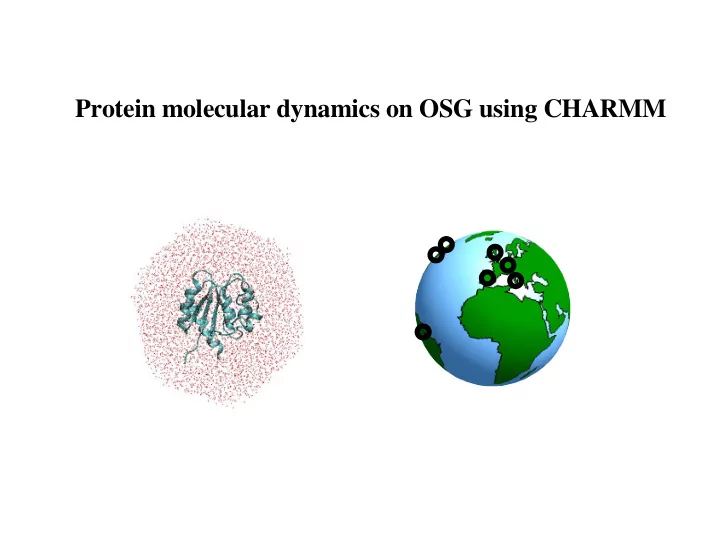

Protein molecular dynamics on OSG using CHARMM
Structure -> Dynamics -> Function Timescales of protein motion: femto-pico : bond vibrations, angle bending pico-nano : loop motions, surface sidechains, water penetration nano-micro: folding in small peptides, helix-coil transitions micro-seconds: conformational rearrangements, protein folding, catalysis Physical complexity: Environment: water, various shapes, sizes, membrane, pH, ions, bound non-protein molecules gases, small molecules, macromolecules
Molecular dynamics simulations All atoms described explicitly (including water molecules, ions). Interaction between atoms through empirical potentials: bonded terms: bond vibrations, angle bending, dihedrals ... non-bonded terms: electrostatic, van der Waals. Time evolution of the system obtained through integration of Newton's equation of motion. Integration timestep is 1-2 fs. Motions at the order of ns, or 10-100 ns are accessible through MD simulations.
Why we need the grid? * Achieve statistically meaningful results (most experimental techniques deal with ensembles). This will become possible for processes that occur on timescales of 10-100 ns (water penetration). * Increase probability of observation of processes that occur on timescales longer than microseconds: protein folding, protein conformational transitions. * Simulate related proteins (comparative study) * Simulate proteins under slightly different conditions (e.g., with bound protons or small molecules)
Understanding protein conformations Understand effects of long time dynamics on structure and function. and protein conformational transitions Protein conformation can be changed through changes in environment (such as pH) or binding of small molecules. This can be used as a mechanism of CONTROL of protein activity.
Conformational changes induced by phosphporylation Phosphorylation Phosphorylation favors active vs inactive conformation. There are two NMR structures of the active form. Run simulations for: 1) active1, phosphorylated 2) active1, unphosphorylated 3) active2, phosphorylated 4) active2, unphosphorylated 5) inactive, phosphorylated 6) inactive, unphosphorylated
What is CHARMM? CHARMM is a general and flexible software application for modeling the structure and behavior of molecular systems. More information is available at http://www.charmm.org. * variety of systems: small molecules - large oligomeric proteins in its solvent environment * QM/MM potentials * energy minimizations, molecular dynamics, vibrational analysis * variety of analysis tools
System setup 2,000 protein atoms +16,000 water atoms =18,000 atoms Typical sequence of a CHARMM molecular dynamics job heat equil run1 ... runN anal
With a software that can babysit the jobs while we sleep ... software managing your jobs Input Output
Implementation of CHARMM on the OSG What do we need to have (requirements)? ● A way to set up various run parameters. ● Ability to submit and track many jobs. ● Easy access to input and output files from the grid. What application specific challenges must we deal with? ● The framework must allow for maximum flexibility since CHARMM can do many things. ● Efficient handling of many input and output files. ● Figuring out queue lengths and resource limitations and tailoring jobs to them. ● Restarting failed jobs.
Solution: Use PanDA and a custom set of management scripts The Scheduler Interface ● We use the PanDA front end. ● We also use TestPilot and run our own pilot scheduler for maximum control. ● Users can track jobs via a Web interface.
CHARMM Job Management ● Thread and wave model. Each independent case is a thread and each step in the analysis is a wave. Each job can have many threads with the same waves. ● The individual jobs keep track of their state information and pass it to the next wave in the thread. ● Each job automatically submits the next wave in the thread upon its own completion. I=1 heat equil run1 ... runN anal ... I=2 heat equil run1 runN anal . . . I=M heat equil run1 ... runN anal
Job definition from the researcher's point of view The following steps are required to set up and submit a job: 1. Obtain CHARMM and the PandaForCharmm software. 2. Create the various input scripts needed for the jobs. 3. Pack these and other necessary files into a tar.gz to be extracted on the execution host. 4. Modify parameters in charmmJob.sh, example: Example thread and wave parameters: export tarball=ana2.tar.gz export exe=c33a2-lrg.one export jobname=ana3 export threadparams="I=[jobid]" export inpscripts="heat=heat.inp,equ=eq.inp,md=run.inp" export threaddef="heat,equ*2,md*2" 5. Run charmmJob.sh 6. Watch your jobs run!
The Web Interface (constructed by Torre Wenaus)
Where we are and where we want to go Currently: ● Basic set up of the thread and wave model is completed and we've tested our own scripts extensively. ● We have started production runs with fifty threads of twelve waves. ● 100K step jobs are taking about 1 day to finish. This means we can simulate 1 ns per thread in 180 to 300 hours of wall time! Future Directions ● Ability to introduce “branches” in the script sequence, to allow, for example, extra analysis of “interesting” structures. ● Better tracking of in-progress jobs along with failure detection and possible correction. ● A graphical front-end for job definition and submission. ● Gaining a better understanding of various sites and queues so we can better match jobs to resources.
Thank You! NIH Bernard Brooks Fermilab/Johns Hopkins University Petar Maksimovic Open Science Grid Wensheng Deng (BNL) Torre Wenaus (BNL) Frank Wuerthwein (UCSD)
Recommend
More recommend